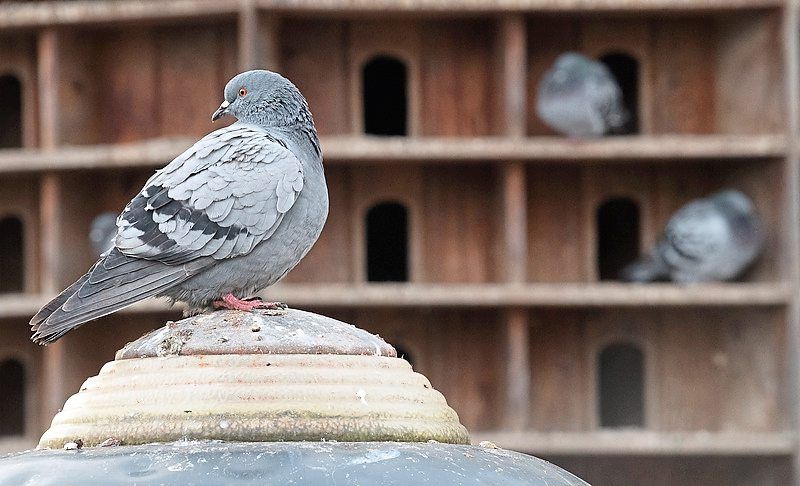Feral pigeons are often descended from domestic birds – but find few fans when they are wild. Photo: dpa-mag/dpa-Zentralbild/Patrick Pleul
Nesting on balconies, fouling buildings with their droppings and scavenging for food: It is no wonder people don’t like pigeons, calling them a public nuisance and complaining about their rampant breeding.
But some argue that maybe we just don’t get the birds – and perhaps we are the problem.
“City pigeons are escaped domestic pigeons,” says German vet Jens Hubel, who specialises in ornamental, zoo and wild birds. Most are descended from wild rock pigeons and are stray homing pigeons or birds bred for their meat.
“We don’t know exactly how the gene pool is composed, but there are many carrier pigeons among them,” says Hubel, who sympathises with these cooing, pooping outcasts that struggle in our midst.
Flocks of pigeons often include ringed birds that once belonged to breeders who decided they had no further use for them.
“Birds that fail to find their way home are of no interest to pigeon racers,” he says, estimating that 20,000 to 30,000 racing birds get lost every weekend during the April-to-September flying season.
Other breeds also entered the city pigeon gene pool, as evidenced by their shorter beaks and feathered feet. But city and wild pigeons are also generally so distinct that they cannot reproduce together, and their breeding places are also completely different.
Since all feed mainly on waste in cities, it is unsurprising that some slam them as germ-infested “rats of the sky”. But they are not the insidious threat to human health that people are led to think.
“The importance of the urban pigeon as a carrier of diseases is overstated,” says Hubel. “The risk is no greater than with other animal species such as sparrows, crows, chickens and cats.”
It’s true that avian parasites like the red bird mite can become a problem when birds abandon their nests, because the mites then look for new food sources, such as humans. People can also theoretically catch respiratory tract infections through chlamydia psittaci bacteria.
However, according to Hubel, this only affects a few people – in Germany at least – each year, mainly parrot owners and pigeon breeders. City pigeons are rarely the cause.
As a rule, pigeons are also not responsible for salmonella infections in humans. Only 1.3% of salmonellae detected in city pigeons are rated as being particularly pathogenic for humans.
People also worry about moulds but they are not transmitted by city pigeons or other animals: “It’s a myth that unfortunately still persists,” says Hubel.
Nonetheless, people who have a great deal of close contact with pigeons and their excrement, professionally or otherwise, are advised to wear protection. Pest controllers, cleaners and pigeon fanciers should wear closed glasses or goggles, masks and gloves, and change their clothing after contact.
Even pigeon sympathisers concede that while the birds are not overtly dangerous, they can at times be a nuisance. Large flocks can damage metal areas with their acidic droppings. Broken roof trusses can be an invitation for them to nest if not quickly repaired.
Anyone who already has city pigeons breeding on their roof or balcony should get help, experts say.
One way people stop the birds from breeding is by replacing any eggs they see in a nest with fake ones, to prevent them from hatching. Hubel says you can remove the eggs easily in the first three days after they are laid, and you can boil them and put them back in the nest or replace them with plastic eggs.
If you don’t know exactly when the eggs were laid or whether they really are city pigeons, consult a specialist, for example from a local pigeon protection association.
They can determine whether the pigeons are the city variant or protected wild pigeons, when the egg was laid and whether it can still be replaced or needs to be allowed to hatch. Many associations also help with the removal of pigeon offspring and provide tips on dealing with breeding sites.
Injured or listless birds should be gently caught by passers-by, reported to the environmental authorities and, if possible, taken to a vet who specialises in birds, for emergency care.
“Pigeons often don’t show their suffering, their plumage also hides drastic weight loss,” says Hübel.
What is needed, in his view, is a strategy for urban pigeon management. “We need pigeon lofts where the animals can defecate for the most part, feed in the loft, and an egg exchange.”
One successful approach is to ensure there are sufficient pigeon lofts available near areas where the birds congregate. The strategy can be underpinned by closing off alternative breeding sites and banning feeding nearby to help the pigeons settle in their new home.
More and more German cities are testing this strategy and Berlin wildlife officer Derk Ehlert says pigeon numbers have fallen significantly in recent decades, from 150,000 birds in 1980 to 19,000 in 2022.The city attributes the overall decline to increasing pigeon control measures and thus fewer breeding sites. – dpa/Marie Von Der Tann







